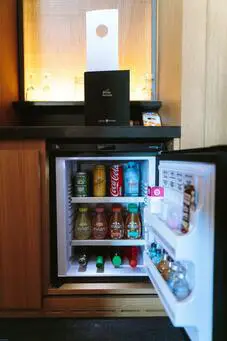Do you own a mini-fridge? Do you know how the mini-fridge temperature range? One of the difficulties of sharing an apartment with a large group of people is figuring out how to allocate fridge space—or who is responsible for eating your favorite dip.
Investing in a personal mini-fridge is the most effective solution to this issue. If you’ve had a housemate who might consume everything, don’t use that as an excuse. Instead, consider how much time you’ll save by not having to run to the fridge to get a cold bottle of water.
What Is A Mini-Fridge?
A mini-fridge is a small, standalone refrigerator that is typically used in college dorm rooms or small apartments. Mini-fridges are usually less than four feet tall and two feet wide, making them small enough to fit on a desk or countertop.
Most mini-fridges have a single door that opens to reveal shelves for food storage, as well as a small freezer compartment. Some models also come with a built-in ice maker.
While mini-fridges are not as spacious as full-sized refrigerators, they are still large enough to hold a decent amount of food and drinks. And because they are so compact, mini-fridges use less energy than larger models, which can help save money on your utility bills.
How To Set The Temperature On A Mini-Fridge
Most mini-fridges have a temperature range of between 32 and 41 degrees Fahrenheit. To set the temperature on your mini-fridge, start by making sure that it is turned on and plugged into an outlet. Then, locate the temperature control knob, which is usually located near the top of the fridge.
Once you have found the knob, turn it to the desired setting. If your mini-fridge does not have a temperature control knob, or if you are having trouble finding it, consult your owner’s manual for instructions. Mini-fridges are typically very energy-efficient, so you should not need to worry about running up your electric bill by keeping them in a cold setting.
However, if you notice that your mini-fridge is not cooling properly, be sure to check the seals around the doors and the condenser coils to make sure that they are clean and unobstructed.
What Is The Ideal Mini-Fridge Temperature Range?
Mini-fridges are popular household appliances, and they come in handy for storing food and drinks. But what is the ideal mini-fridge temperature range?
Most mini-fridges have an adjustable thermostat, so you can set the temperature to your liking. However, the ideal mini-fridge temperature range depends on what you’re planning to store in your fridge.
For example, if you’re going to be storing mostly drinks, then you’ll want to keep the temperature on the colder side, around 35 degrees Fahrenheit. On the other hand, if you’re planning to store mostly food, then you’ll want to keep the temperature a bit warmer, around 40 degrees Fahrenheit.
Of course, these are just general guidelines. The best way to figure out the ideal mini-fridge temperature setting for your needs is to experiment a bit and see what works best for you. Mini-fridges are fairly inexpensive, so if you find that you’re not happy with the temperatures you’re getting, it’s always easy to buy a new one and start fresh.
Pros And Cons Of Having A Mini-Fridge
A mini-fridge can be a great addition to any home, providing a convenient way to store food and drinks. However, there are also several potential drawbacks to consider before making a purchase.
One of the main benefits of a mini-fridge is that it can help to save space in your kitchen. If you live in a small apartment or have a limited amount of storage, a mini-fridge can be a great way to keep your food and drinks cold without taking up too much space.
However, mini-fridges also tend to be less energy-efficient than larger models, so they may not be the best choice if you’re looking to save money on your electric bill.
Additionally, mini-fridges can sometimes be noisy, so if you’re looking for a quiet appliance, you may want to opt for a different type of fridge. Overall, a mini-fridge can be a great addition to your home, but it’s important to weigh the pros and cons before making a purchase.
Conclusion
When it comes to setting the temperature on your mini-fridge, it is important to consider what you plan on storing inside of it. If you are mostly storing drinks, then you will want to keep the temperature on the colder side. However, if you are mostly storing food, then you will want to keep the temperature a bit warmer.
Ultimately, the best way to figure out the ideal temperature for your mini-fridge is to experiment a bit and see what works best for you.
Other Related Topics
What Is A Mini-fridge Fan?
A mini-fridge fan is a small, portable fan that helps to circulate air and keep food items cool inside a mini-fridge. mini fridge fans are often used in college dorms or other small living spaces where a full-sized fridge is not available.
They can also be used to keep food items cool during power outages or other situations where refrigeration is not available. Mini-fridge fans typically plug into a standard outlet and run on electricity.
Some models also come with batteries, which can be helpful in the event of a power outage. Mini-fridge fans come in a variety of sizes and styles, so it is important to choose one that best fits your needs.
What Is A Mini Fridge Thermostat Wire?
A mini-fridge thermostat wire is a type of electrical wire that is used to connect mini-fridges to their thermostats. This wire is typically made from copper or another type of conductor, and it is insulated to protect against electrical shocks.
The mini-fridge thermostat wire must be able to handle the high current that flows through it when the mini-fridge is turned on. It is also important that the mini-fridge thermostat wire be able to withstand the high temperatures that are generated by the mini-fridge.
Mini-fridge thermostat wire is typically made from stranded copper wire, which is composed of many small strands of copper that are twisted together. This type of wire is very flexible and can be easily routed through tight spaces. It is also resistant to heat, making it an ideal choice for use with mini-fridges.


